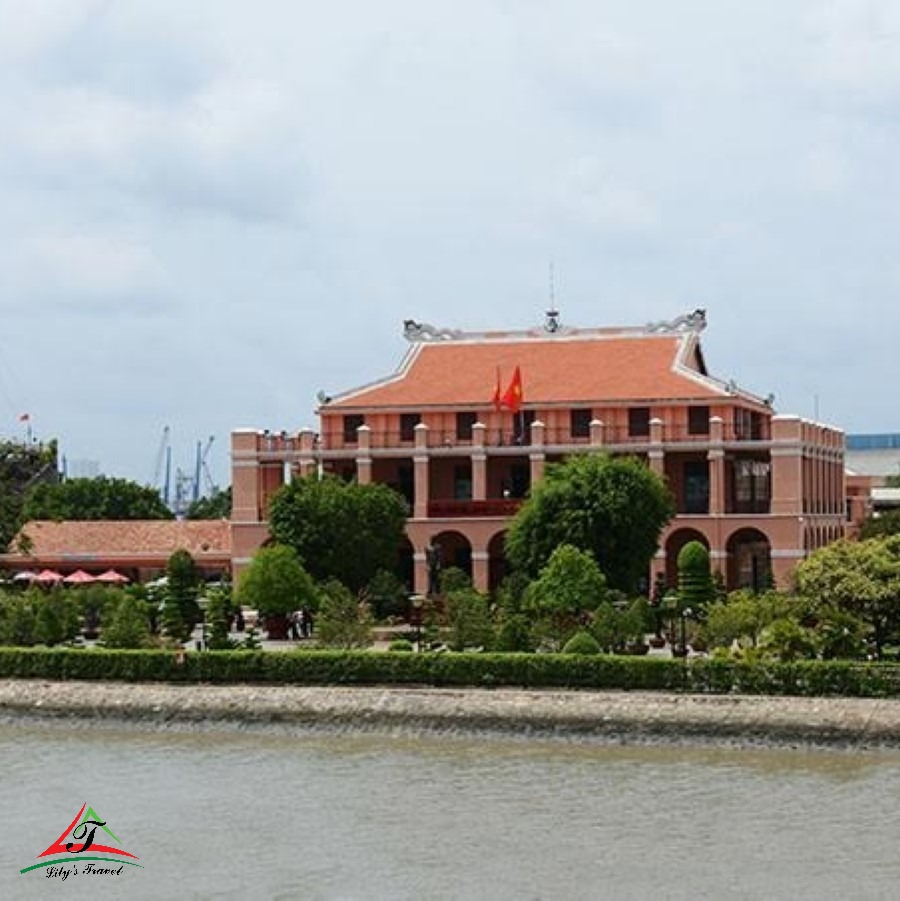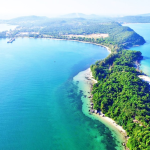Nha Rong Port witnessed many important events in Vietnam’s history. This place used to be an essential trading center of the region; many international ships visited and traded here. Nha Rong Port also opened a revolutionary path for the Vietnamese people when this is where President Ho Chi Minh went to find a way to save the country.
Nha Rong Port is the oldest French architectural structure in Indochina

There is still much debate about the name of Nha Rong Port. However, the current popular explanation is that The Port is only Ben Nghe, a marina located on the Tan Binh River, the former name of the Saigon River. Tan Binh River was recorded in Gia Dinh Citadel, the set of localities on the southern land of the nineteenth century by Trinh Hoai Duc: Tan Binh Giang in front of Gia Dinh Citadel in the area of Tan Binh district, traditionally called Ben Nghe River. The river is 142 meters wide, 10 levels deep, the net water is 13 meters (about 5 m) deep, and the vast river is deep and clear. Ben Nghe’s name is Ngu Chu. The river is broad and deep; it is said that many crocodiles, each herd, chase each other, roaring as if calling the pack, so the name is like that.
Nha Rong Port is home to the headquarters of the Messageries Imperials, a French shipping company built around 1863. The building’s architecture is in the Western architectural style. Still, on the roof, there are two giant green glazed terracotta dragons, the head of which enters the moon according to the motif “Dinosaurs adore the moon” – a familiar decoration of the Vietnamese pagoda communal house, hence the name Nha Rong.
The book “Geography of Gia Dinh – Saigon – Ho Chi Minh City” said that the capital of Gia Dinh in the past consisted of the entire South of our country, located in Ben Nghe, which has many favorable conditions with an unparalleled good geography. This is a large area that is not flooded every year, like in the Mekong Delta. This place also has many freshwater wells, and when the climate is pleasant, it becomes a place where birds land for people to work and live. At the same time, it is also a strategic gathering place for the navy to maintain security and order for the South of the country.

In the past, Ben Nghe was a famous trading port in the South of Vietnam, under the crowded river and boat with thousands of boats. From Ben Nghe, there is a waterway throughout the South, which is very convenient. Gia Dinh Thanh Chuong’s book said: The merchant ships of our country and other countries, riverboats and large and small boats parked consecutively, the masts connecting each other, is a great meeting place. It was once one of Southeast Asia’s largest and most important ports.
Read more: Moc Chau tour: The Northwest Vietnam destination has just been honored at the international awards
In 1859, the French invaders marched from Da Nang to the South, entered the Ben Nghe River, and attacked Gia Dinh’s citadel. Ben Nghe is often mentioned in patriotic poetry in the nineteenth century. On May 5, 1911, from Nha Rong harbor, the young man full of revolutionary ambition Nguyen Tat Thanh, under the name of Van Ba, was determined to find a way to save the nation on the Admiral Amiral Latouche Tréville ship Five Star (Chargeurs Reunis).
Experiencing and understanding the unsuccessful causes of patriotic movements in the early twentieth century of his predecessors, with the political vision and enthusiasm of youth, Nguyen Tat Thanh went to the West to learn about other countries and then returned to help his compatriots: “I want to go abroad to see France and other countries. I shall return to assist our countrymen after witnessing how they fare.”
On July 6, 1911, the ship docked at the port of Marxism, the land of France. It was the first place where Nguyen Tat Thanh arrived and discovered the most surprising thing: Poor people from Vietnam were also here. Since then, he is determined to use labor to find the truth. On the journey to find a way to save the country, he went to many countries in Asia, Europe, America, and Africa… to understand the nature of imperialism, the suffering, and the fate of the colonial people. With a broad vision, analyzing the ideological and revolutionary trends of the era, he came to Marxism-Leninism. He was determined to follow the path of the October Revolution, the world proletarian revolution.
From Nha Rong Port, after 30 years of traveling across five continents, both working and studying, studying the theory and practice of the world revolution, Nguyen Ai Quoc returned to his country, bringing with him a precious asset, which is the revolutionary path, the path of national liberation of Vietnam. The Vietnamese Revolutionary Road created by Nguyen Dai Quoc – Ho Chi Minh is the cornerstone for all Vietnamese Revolutionary successes.
Read more: Ha Noi Travel: 6 tours in the night for you to discover “the difference of Hanoi”
Past and Present

Nha Rong Port is where many important historical events occurred for the nation and the country. On April 30, 1975, the red flag with the yellow star was raised here, marking the victory of our army and people in the war for national independence and unification. Immediately after the country’s reunification, the Dragon House was retained as a monument to President Ho Chi Minh according to Decision No. 1315/QD-UB, dated July 9, 1979, of the People’s Committee of Ho Chi Minh City. Nha Rong Port not only has historical significance, but it also has unique and attractive architecture. The architecture of Nha Rong Port combines European art and typical Southeast Asian architecture, creating a unique cultural heritage for the city. Nha Rong Wharf has been restored to its original state and has become one of the city’s famous tourist attractions.
The Ho Chi Minh Museum – Ho Chi Minh City branch is now located at 1 Nguyen Tat Thanh, Ward 12, District 4. This is one of the non-commercial units of Ho Chi Minh City’s Department of Culture and Sports, as well as a branch of President Ho Chi Minh’s System of Museums and Monuments in the country.
Nha Rong Port holds special historical significance for the Vietnamese people. Uncle Ho used to reside here, and he came here to find a method to save the country. In addition, Nha Rong Port is also a place to store and display many artifacts and images of Vietnamese history. Visitors can also visit and learn about the life and history of the nation, especially the journey of President Ho Chi Minh to find a way to save the country.
Nha Rong Port is a crucial turning point in the country’s quest for independence and reunification. This is one of the must-see places to learn and experience the culture and history of the nation.
The best center Vietnam tour: Tour in Vietnam















